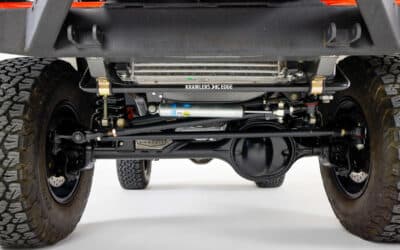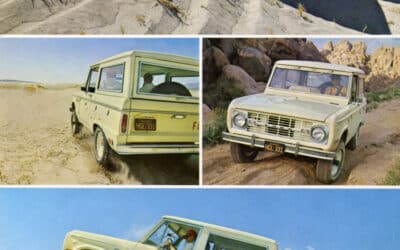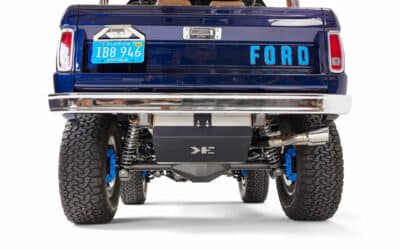As winter approaches, it’s time to learn how to properly prepare your first gen Bronco for both long-term storage and challenging winter drives. This comprehensive guide on winterizing your Ford Bronco will provide you with all the necessary steps to ensure that your classic vehicle remains in top condition throughout the colder months.
Why Winter Prep is Essential for Your Bronco
Winter can be harsh on any vehicle, but most people take a little extra care when prepping their classic cars.
Cold temperatures, moisture, and road salt can cause significant damage to your Bronco’s bodywork and mechanical components. By spending a little time preparing your vehicle for winter, you can mitigate these risks and prolong your Bronco’s lifespan.

The Risks of Salt and How to Mitigate Them
Road salt is a necessary evil in regions experiencing snowy winters. Though effective at melting ice and improving road safety, salt can wreak havoc on your Bronco’s frame and components by promoting rust and corrosion. If you drive on salted roads (and we do sometimes in Tennessee), make sure to clean your vehicle thoroughly afterward, paying particular attention to the undercarriage, wheel wells, and other hidden areas where salt can accumulate.
Salt = bad for Bronco.

Staying Warm in Your Bronco During Winter Drives
Driving a Bronco in winter can be a fun but chilly experience. To stay warm, invest in good-quality winter clothing, including coats and gloves. Keep a blanket in the vehicle for extra warmth. Consider using hot hands or even a battery-operated heated shirt for those particularly cold days.
There were a few winters where I kept my top and doors off all winter long. Was it cold? Yes. Was it worth it? Definitely. I got a lot of weird stares at red lights but I felt alive with the frigid air hitting me the face. Call me crazy.
Proper Winter Storage Options for Your Bronco
If you’re going to store your Bronco try to store it in a garage during winter. This will provide the best protection against the elements. If you don’t have access to a garage, consider using a high-quality car cover. Ensure it’s breathable to prevent condensation build-up, which could lead to rust.

Preparing Your Bronco for Winter Storage: A Step-by-Step Guide
1. Keeping the Fuel Tank Full
Contrary to popular belief, it’s not a good idea to empty your Bronco’s fuel tank before storing it. An empty tank can lead to condensation, which may result in rust or even damage the fuel system.
Instead, keep the tank full to reduce the space where moisture can accumulate.
2. Using a Fuel Stabilizer
Adding a fuel stabilizer to the tank helps keep the fuel fresh and prevents it from gumming up and varnish build-up.
Once you’ve added the stabilizer, drive your Bronco for a few minutes to circulate the stabilizer through the fuel system.
3. Battery Maintenance
If you’re storing your Bronco for an extended period, you should maintain the battery. A battery tender is a great tool to keep the battery charged without overcharging it, which can lead to damage.
It’s also important to clean the battery terminals to prevent corrosion.
4. Tire Care
To prevent flat spots on your tires from long-term storage, consider placing your Bronco on jack stands. This takes the weight off the tires and allows you to maintain tire pressure throughout the storage period.
It’s not the easiest but flat spots are no fun.
Caring for Your Bronco’s Soft Top in Winter
If your Bronco has a soft top, it’s crucial to know how much snow it can handle—generally, it’s best to remove snow regularly to prevent excessive weight and potential damage.
People ask if the soft top is good at keeping the Bronco warm. Not really. It’s winter and it’s cold. Just know that and be prepared for it and you can still have a good time!
Frequently Asked Questions About Broncos in Winter
1. How does the Bronco handle in snow?
With the right tires and 4WD, a Bronco can handle snowy conditions reasonably well.
2. Are Early Broncos 4WD?
Yes, early Broncos came with 4WD as standard, making them capable performers in off-road and adverse weather conditions.
3. Are Broncos good winter cars?
With their robust construction and 4WD, Broncos can be good winter vehicles. However, with their vintage status and value, we know a lot of owners prefer to store them during winter to protect them from the elements and road salt.
If you’re a driver or a storer, it’s cool. Do what is right for you!
4. What type of emergency kit should I keep in the car?
We always have blankets, warm clothing, an ice scraper, a flashlight, jumper cables, water (and water filter), some food, and a first aid kit.
Conclusion
Properly preparing your Ford Bronco for winter is crucial to preserve its condition and performance. Whether you choose to store it or brave the winter roads, following these steps will help ensure that your Bronco is ready for whatever the season brings. At Kincer Chassis we know that a well-cared-for Bronco is a Bronco that will provide enjoyment for years to come.





